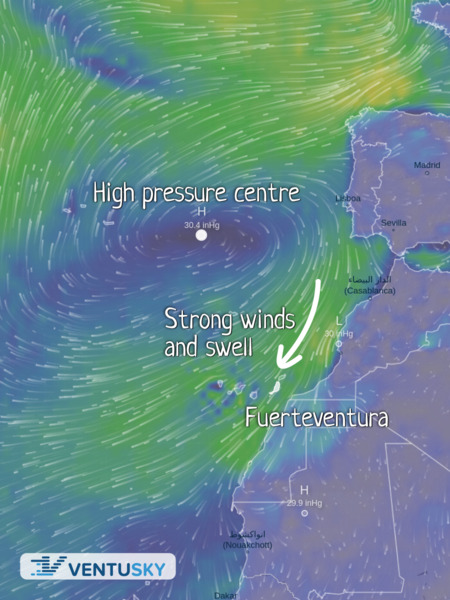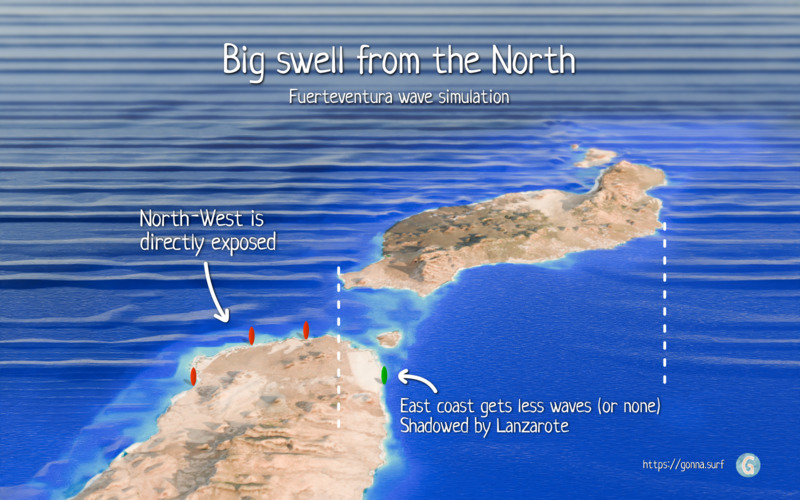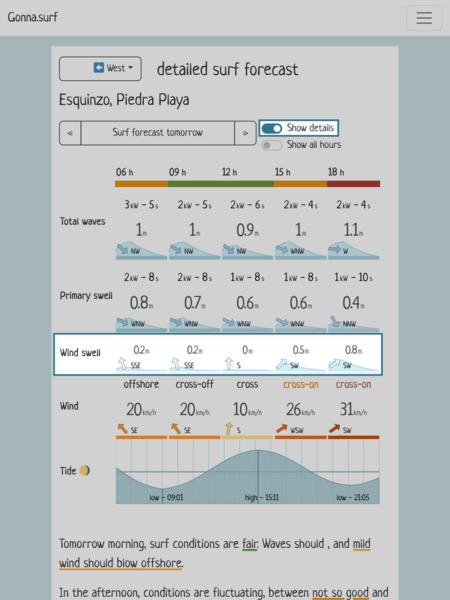4 surf spots for improvers
Discover the most suitable spots in Fuerteventura North to practice and progress
7 minute read. Last update: 7 Feb 2024.
As an improver surfer, you want to:
- practice your pop-up, take-off more consistently,
- learn how to turn on the surfboard.
Some spots in the island are great for this. They offer a large quantity of waves, so you have more opportunities to catch some, and less waiting.
Keep in mind that the weather conditions greatly affect how the waves behave in each spot, so pay attention to the forecast.
If you are an intermediate, meaning that you already surf consistently, you might want to read surf spots for intermediates instead. We're also planning to write a third companion article, with spot recommendations for beginners, stayed tuned.
Contents
Safety considerations
Let's keep the sport fun and safe for everyone, shall we? Before paddling out, make sure that the conditions are suitable for your level. Are the waves too big? Is there a lot of current? If it's a reef break, are you sure that you can avoid being pushed towards the rocks? If in doubt, do not hesitate to ask people around about the conditions before getting in the water.
Make sure that you respect the rules of surfing. If needed, learn about the surf etiquette in this article by Barefoot surf*.
If you are not able to turn yet, do not use a hard board, and stick to a soft board. You don't want to crash into someone else with a hard board. While it is not easy to learn how to turn with a beginner's 8 feet+ board, there are thinner and shorter soft boards which are more maneuverable and let you learn safely (lengths between 6'0 and 7'0). Try them, they are fun, really.
Recommended spots for improvers
Punta Blanca
Punta Blanca is one of the best spot for improvers to practice. This wide reef break spot in the North shore delivers a long and fun right-hander wave.
Here are four reasons making Punta Blanca a top choice for progressing:
- Punta Blanca gets more breaking waves than most spots in the area. You usually don't need to wait much (or at all) for a set to come.
- The waves tend to be mushy, not too steep, hence easier to catch.
- It is easy to reach the line-up and catch green waves, thanks to a channel on the side, where waves don't break, and with currents helping you paddle out.
- Icing the cake: the rides are very long.
Generally, if you perhaps get 3-5 waves during a session at another spot, you are likely to be able to get 15 - 20 waves during the same time at Punta Blanca.
What's the catch? There are some downsides to this:
- Wave quality is not the best, the conditions are often pretty choppy. The wave - a right-hander - quickly fades into the channel, so you need to either surf straight, or be able to turn back to the left, to keep riding it.
- While you don't need much power to reach the line-up, thanks to the channel, you have to have some endurance, as the distances to paddle are long.
- The spot tends to be crowded. Surf schools go there with their groups of intermediates, as well as people surfing on their own.
Still, overall, favoring quantity over quality is certainly a good choice if you want to progress.
You can learn more about Punta Blanca by checking out our visual spot guide: Punta Blanca Essentials.
La Caleta
La Caleta is a left-hander surf spot also located in the North shore. It tends to be cleaner than Punta Blanca, but catches less swell. The spot is small, and easily gets crowded. Make sure that you know how to behave well if you go surfing there : stay out of the way of other surfers, hold your board, respect the surf etiquette. Do not paddle out on the super clean days when it's crowded.
In a nutshell, Caleta give you more quality, and less quantity than Punta Blanca.
Learn how to surf at La Caleta in our visual spot guide: La Caleta Essentials.
Piedra Playa
Piedra Playa is a beach break right outside of the village of El Cotillo, in the West coast.
The wave breaks very quickly, the rides tend to be short, but exciting. It teaches you to take-off and turn right away.
The spot only gets interesting smaller days. Most of the times, the wave is closing out. Movement of the sand banks keep the situation changing.
Safety: make sure you are able to identify shore breaks - these waves breaking very close to the shore, in very shallow water - and don't surf whenever the wave breaks that way.
Discover Piedra Playa in our visual spot guide: Piedra Playa Essentials.
Playa del Moro
Playa del Moro is a beach break in the East coast, a few km South of Corralejo.
East coast is protected from the swell forming in the Atlantic ocean, as the coast of Morocco is not far East, and Lanzarote island blocks the swell coming from the North. It is therefore a good choice when the waves are too big in the West or in the North.
Moro is a pretty classic beach break. Multiple peaks, the channel is not clear from breaking waves, so depending on the conditions, you might need some paddling power and good timing in order to reach the line-up.
Here's a map link to reach Playa del Moro's location.
Where to go based on the surf forecast
Besides the weather conditions, the good spot for you also depends on the board you're using, what you want to practice, your physical conditions, your level of self-confidence and your preferences.
While there is no absolute answer to the question of where you should go surfing, we can still provide some useful pointers.
Where to surf when there is some big swell
Most of the time, bigger swells come from the North. They are formed by storms forming near the Azores Islands, and traveling towards Europe. This weather phenomenon is called the Azores high and tends to happen relatively frequently in winter.

If the waves are higher than
The swell coming from North-West doesn't wrap much around La Caleta, so it might be a suitable option when the swell is from that direction.
In the West, Piedra Playa is likely to be too big, as swell from the North reaches that coast pretty well.
Thanks to Lanzarote island, the East coast is protected from the swells coming from the North Atlantic, as shown in the illustration below. Playa del Moro sometimes has small waves generated by the wind, and can then be a safe and fun alternative when the North is too big and too messy.

Where to surf in medium conditions
Clean days can be very fun all around. Pay attention to both the swell and wind direction arrows in order to know which coasts are getting waves.
Where to surf when the waves are very small
In the North shore, Punta Blanca is a swell magnet: it is exposed to swells coming from all northern directions, and is more likely to get a breaking wave than most other spots in the North coast. It tends to get super crowded these days though. Time your session accordingly, be patient and share the waves.
In Playa del Moro, even if there is no ground swell, there might be some wind waves, and opportunities to surf them. Activate the "show details" option in the hourly surf forecast for the East coast, and check: if the wind waves' height is higher than

Final thoughts
We wish you a lot of fun and progress during your surf trip in Fuerteventura North. Take your time, relax, enjoy the experience. Always make sure to stay safe, and keep others safe.
While we have given general recommendations, the weather conditions greatly affect how each spot behaves, so check by yourself and ask to people around you. Some other spots not listed in this article might also be good for your level. Just, make sure that it is not a local spot, or too advanced, before getting into the water.
Now check the hourly surf forecast and go surfing 🤙!
Did you find these recommendations useful? If yes, we would greatly appreciate your support to help us create more content.
* Gonna.surf is affiliated to Barefoot surf, meaning that we get a commission in case you decide to make a purchase through the link, at no cost to you. The linked article is totally free.